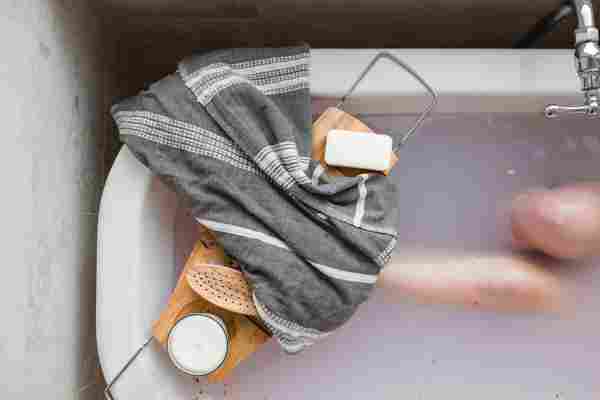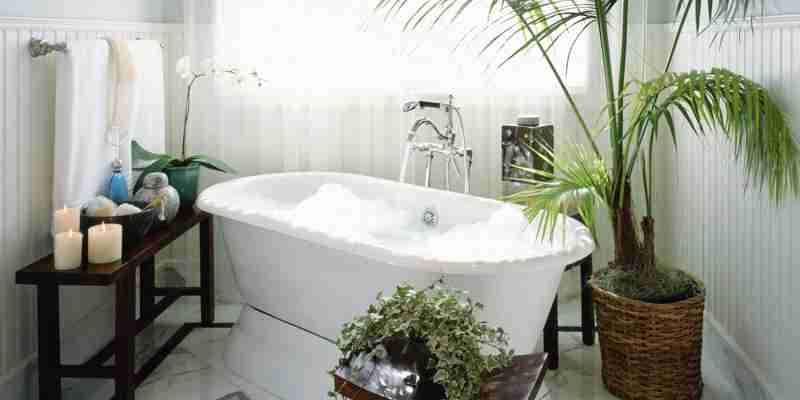A Hot Bath Can’t Solve Everything, but It Can Lower Stress—Here’s How to Make Your Soak Even More Relaxing
E ven in the best of times, a relaxing bath is a legit way to decompress. Few things melt away the ordinary stressors of daily life like a warm-to-scalding, ven in the best of times, a relaxing bath is a legit way to decompress. Few things melt away the ordinary stressors of daily life like a warm-to-scalding, sudsy soak . Now, when stressors have become anything but ordinary, it might make sense to likewise level up the bath in order to meet the day's unprecedented toll on the psyche.

"During stressful times it is even more important to make sure that while we are taking care of others, we are also finding some time to take care of ourselves," says Elena Severin, director of brands at The Detox Market. "Settling into a calming bath is the ultimate pause button since you are forced to sit in one place and come to peace with your surroundings in that moment."
The benefits of a soak can exceed the psychological, too. "In Ayurveda, bathing is seen as more than just relaxing, it’s a powerfully healing and detoxifying self-treatment," says Ayurvedic expert and Surya Spa founder Martha Soffer.
Her version of the ultimate bath follows a specific recipe. "To create your own healing bath at home, add one pound of baking soda, one pound of sea salt, and one pound of epsom salts to your bath as it is filling up," she says. "Then, add to your bath relaxing herbs and flowers such as lemon balm, lavender, roses, verbena, and ashwagandha to soothe your nervous system and reduce inflammation."
Related Stories
A hot relaxing bath, Soffer explains, creates "swedhana," or sweat therapy. "This is powerfully detoxifying because it allows the tissues to release build up toxins that are then excreted through the skin," she says. "The minerals from the epsom salts aid in this detoxification process, the baking soda helps to alkalize your body, and the salt cleanses your aura.” (As an alternative, Surya sells bath soaks to address different conditions, e.g. muscle relief, hormone balance, etc.)
Soffer's not the only fan of sodium soaks either. “Bath salts are high in minerals that can relax the muscles, reduce inflammation and detox the skin, leaving it silky smooth," says Shari Auth, DACM, founder of WTHN. "After adding bath salt, I add about 10 drops of essential oil. I use bergamot essential oil ($10) for a relaxing bath (that leaves my bathroom smelling amazing), or rosemary essential oil for an invigorating bath that reduces pain, clears the sinuses, and leaves me feeling energized.”
Severin finds that leaning into aromatherapy while bathing helps prevent her from trying to multitask in the tub. "Incorporating aromatherapy into bath time helps keep me centered as I draw my bath," she says. "Aromatherapy Associates Deep Relax Bath & Shower Oil ($73) starts my mind’s unwind process before I step into the tub; just rub a capful between your hands and onto the torso and breathe."
She's also a fan of utilizing CBD to further your zen, and to this end recommends natureofthings' Fortifying Magnesium Soak ($36). "It combines CBD with magnesium to help sore muscles and encourage a good night’s sleep," she says. Alternatively, you can opt for ingesting CBD in preparation for your bath; however, timing is critical. "Our Mello Sea Salted CBD caramels are made with water-soluble CBD, so it will hit your bloodstream faster than normal edibles—typically within 30 minutes," says Mello Daily founder Boronia Fallshaw. "If you eat one about 15 minutes before drawing your bath, you should feel the heavy chill kick in once you are fully immersed in the tub.”
While the whole point of a bath is to leave to-do lists behind, you can use the time to proactively shift your mindset into a positive space if it feels right. "It is a great time whilst bathing to meditate and set some intentions," says Amanda Raich, Spa Director at La Prairie Spa at Waldorf Astoria Beverly Hills. "Candles are a must; if you are having trouble silencing your inner thoughts, try to stare at the candle and focus on the flickering light. Sometimes I will choose a mantra. I place my hand on my heart and just repeat, for example, 'Life is for me, life is not against me, all my needs are met.’"
Raich also recommends a "large" glass of wine, while LATHER Founder Emilie Hoyt recommends opting for a more neutral beverage. "I’m a big tea drinker, and I used to drink my tea in the bath," she says. "Recently, however, I’ve started drinking my cup of tea about half hour before—I love either chamomile or lemon balm." (So, I suppose you could do both the tea and the wine... this bath is meant to be extra, after all.)
Finally, while you can't access a float tank right now (unless, I suppose, you happen to own one), you can approximate the experience by adding sensory deprivation methods to your tub time. "I throw on Spacemasks Self Heating Eye Mask ($24) to block out the light and replace the to-do lists racing through my mind with daydreams," says Severin. "When your mind is at peace a proper bath feels like you’re in a calm ocean."
Set the mood with one of these 9 calming candles. Plus, here's how to turn your entire bathroom into a spa in five simple steps.
11 Products That Make Soaking in the Tub Even More Relaxing
3 / 11
Essential Oil Bath Bombs
Treat yourself and your senses with these luxurious bath bombs. This set features organic, non-GMO, gluten-free* ingredients in six handmade fizzing bombs. The essential oil aromatherapy blends, cocoa butter and shea butter will leave your dry skin incredibly soft once you dry off.
* Those with gluten intolerance can have adverse side effects from skin care and bath products that contain gluten. The problem in not absorption through the skin, but rather by accidentally swallowing it, which is easy to do in the bath. Learn more about celiac disease here.)
You spend a lot of time in your kitchen and bathrooms, so keep them up to date. Steer clear of these trends that won’t be around much longer.
Buy it now on Amazon.
How to Take the Perfect Bath, According to Science
Find the Right Bath Temperature

Though there isn't a single, "ideal" temperature for bathwater—it comes down to personal preference and the purpose of your time in the tub—for most people, comfortable bath water is around 100 degrees Fahrenheit, Michael Marbach, the director of product marketing at Kohler Bathing, tells Real Simple. And he should know: The company has been in the bathtub business since 1883, when its founder, John Kohler, heated a cast iron horse trough/hog scalder and covered it with enamel—introducing the modern version of the bathtub. Though Marbach's position involves substantially less farm equipment, it does involve using science and research to create the ideal bathing experience, including tub and bathroom design.
Which brings us back to the temperature of bathwater. Because most standard bathtubs don't come with a built-in thermometer, temperature is something you'd have to measure on your own (if you really want to be scientific about it). Or, if you're in the market for a new tub, Marbach says that some of the newer varieties "incorporate digital valves that let you set and control the temperature of the water through an interface panel."
Here are a few more specific temperature guidelines.
To get squeaky clean:
If your bathtime goal is to get as clean as possible, then Melissa Piliang, MD, a dermatologist with the Cleveland Clinic, does have a number in mind. Though she doesn't reveal how she arrived at this temperature, in an interview with the Wall Street Journal, she explains that bathing in water 112 degrees F or lower is the optimal temperature for washing away environmental dirt and bacteria.
To reduce the loss of moisture:
Age also is a factor, Dr. Piliang notes. The epidermis is covered with a protective fatty lipid layer that not only keeps dirt and germs out, but also keeps moisture sealed in. The older we get, the longer it takes our skin to replace that lipid layer. "As we age, we have less tolerance for hot water, which may result in dry, itchy, red skin and possibly even eczema," she tells the Wall Street Journal. Unfortunately, even your favorite moisturizer can't replenish your skin's natural oils, Dr. Piliang adds. Keep your bath temp less-than-scalding to protect your skin from irritation, especially if your skin tends to be on the dry, sensitive side.
RELATED: I Tried Taking an Apple Cider Vinegar Bath, Here's What Happened
To make yourself most comfortable:
Meanwhile, if you're in the bath for relaxation purposes, the correct water temperature is simply the one that feels right to you. Perhaps you were caught in the rain without an umbrella, and by the time you get home, your clothes are soaked through and you're so cold that you can feel it in your bones. In that scenario, you might opt for a warmer bath than usual. Or, let's say you live in a home without air conditioning, and during a heat wave, the only thing that brings you relief is lounging in a lukewarm bath while sipping a cold beer, and reading a book. Again, it all comes down to what you want to get out of any particular bath.
To give your body some balance:
According to Marbach, consider doing a cool rinse after a hot bath (or shower). "Heat penetrates and forces blood flow and circulation," he explains. "A cool, neutral rinse after a hot bath or shower brings the body to a state of homeostasis—a balanced state."
To get a good night's sleep:
Taking a bath in water that's a neutral temperature—meaning that it's similar to the temperature of the human body, or around 94-98 degrees F—can be beneficial before bed. "This can provide a relaxing effect on the nervous system of the body," Marbach says.
What about a room temperature bath?
Another temperature-related part of bathing is the air temperature in the room itself—which Marbach says also comes down to the preference of the bather. "Some bathers like to have a minimal temperature change between the bath water and the air," he explains, "while others enjoy the rejuvenating contrast between warm bath water and cooler air temps."
